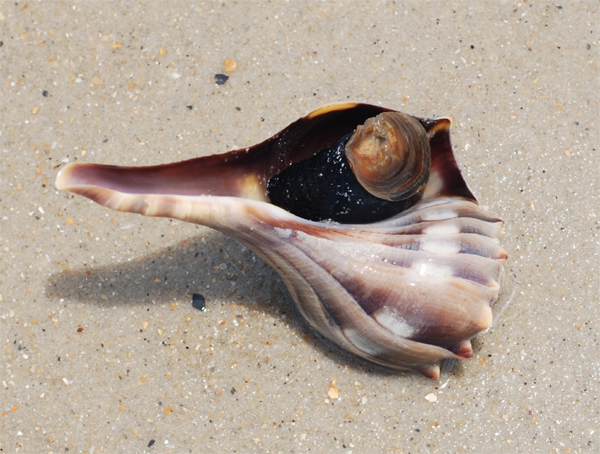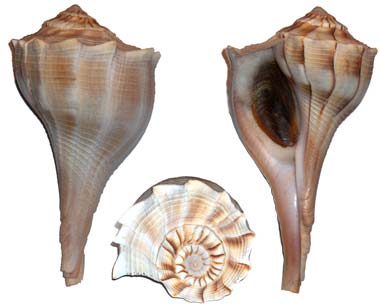Lightning Whelk; photo by Jarek Tuszynski on Wikipedia (use permitted with attribution / share alike).
Official State Shell of Texas
Texas designated the lightning whelk (Busycon perversum pulleyi) as the official state shell in 1987. All Marine-Life Symbols
Large and distinctive; the lovely Lightning Whelk is found only in the Gulf of Mexico and Southeast Atlantic coast of the USA. The lightning whelk is one of the very few shells that normally opens on its left side (most spiraling shells open to the right). Lightning whelks grow to one foot in length (though 15 inches has been recorded). Strong summer storms often wash large shells ashore - if you should find a live whelk, please put it back in the water where it belongs.
Whelk shells have inhabited these waters for 60 million years and have been significant to human cultures. Native Americans used whelks as food, housewares and weapons; the natural shape of the shell lends itself to practical uses (for instance, large whelks of all kinds have been used worldwide as lamps).
Even Whelk egg cases were utilized. Long ago, sailors used sandy clumps of egg strands to scrub themselves. Left-handed shells are considered sacred in parts of Asia and India, where a left-hand Whelk is very rare, so sailors visiting the Western hemisphere collected the common left-handed Lightning Whelk to sell for a profit in the East. This commerce continues today.
House Concurrent Resolution
WHEREAS, The State of Texas has traditionally recognized certain terrestrial forms indigenous to the state as official state symbols; and
WHEREAS, The bluebonnet, the pecan tree, the mockingbird, the topaz, and the palmwood are examples of some natural specimens that serve to symbolize the rich diversity of the plains, forests, skies, and mountains of our vast state; and
WHEREAS, In keeping with this custom, the designation of the Lightning Whelk as the State Shell of Texas will provide suitable recognition for the beautiful beaches and inlets of our Gulf Coast region; and
WHEREAS, Texas' coastlands, bays, and tidal flats provide a total of 634 miles of valuable natural resources and recreation areas, attracting thousands of visitors annually to this lush locality; and
WHEREAS, The Lightning Whelk, Busycon perversum pulleyi, is one of the most attractive and plentiful of the many shells lining our lovely beaches; and
WHEREAS, Found only along the West Coast of the Gulf of Mexico, the Lightning Whelk received its Latin name in honor of the late Dr. T. E. Pulley, a well-known Texas naturalist and teacher; and
WHEREAS, Of approximately 100,000 varieties of shells worldwide, the Lightning Whelk is the best known and one of the very few shells that normally opens on its left side; and
WHEREAS, The delicately sculptured specimen recently received national recognition when it was selected to appear on one of the first shell stamps ever printed by the United States Postal Service; and
WHEREAS, As enchanting as it is unique, the Lightning Whelk is the ideal choice for a state shell and will serve as a fitting emblem of the exceptional beauty of the Texas Gulf Coast region; now, therefore, be it
RESOLVED, That the 70th Legislature of the State of Texas hereby designate the Lightning Whelk, Busycon perversum pulleyi, as the State Shell of Texas.


